Dancheong – Temple Colours: 단청
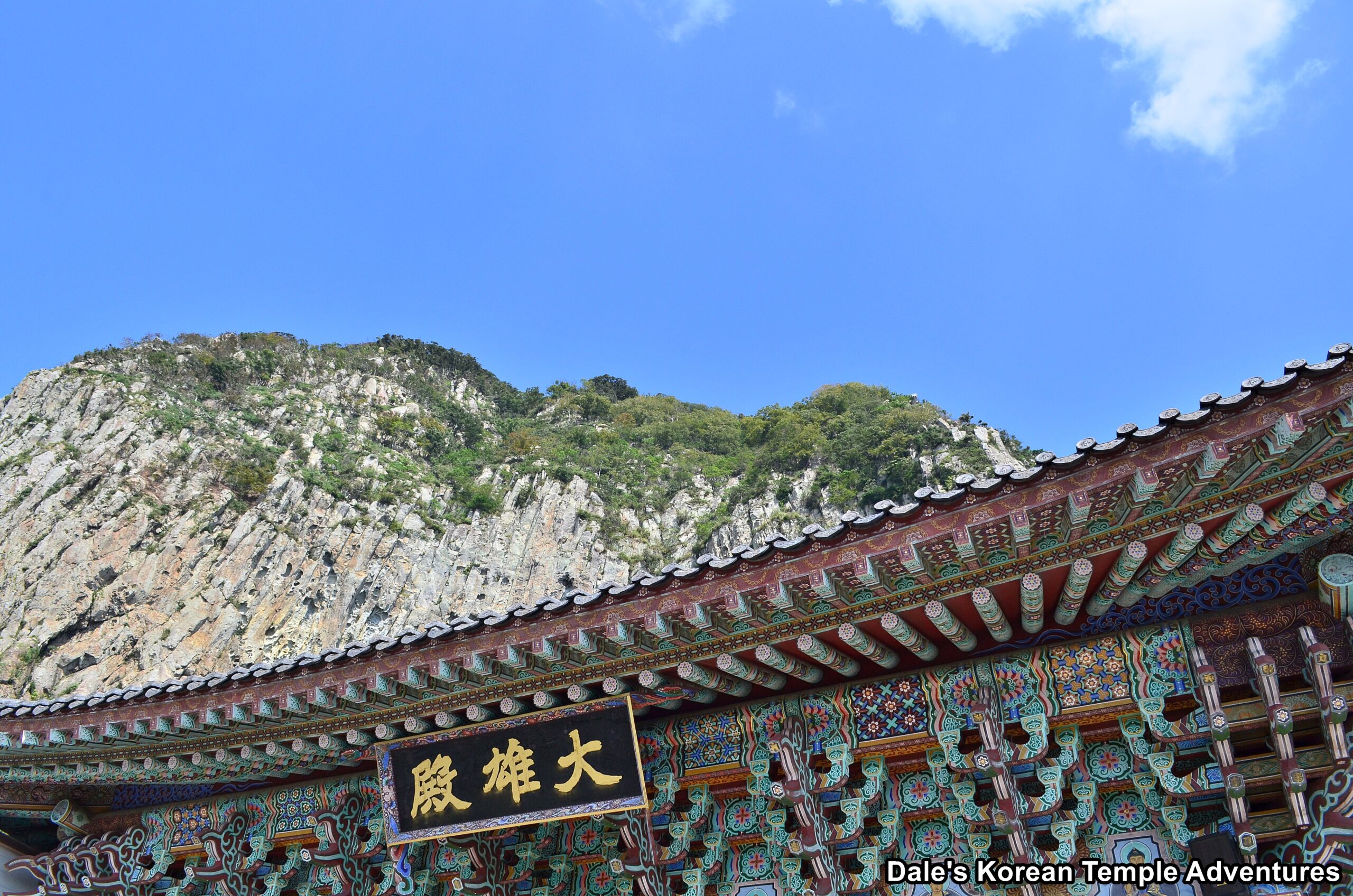
Dancheong Introduction
One of the most recognizable features that distinguishes Korean Buddhist temples from a Japanese or Chinese Buddhist temple are the elaborate colours and motifs. Korean Buddhist temples are decoratively painted in a myriad of colours that include reds, blues, greens, yellows, blacks, and whites. So why exactly are they adorning Korean Buddhist shrine halls, and what do they all mean?
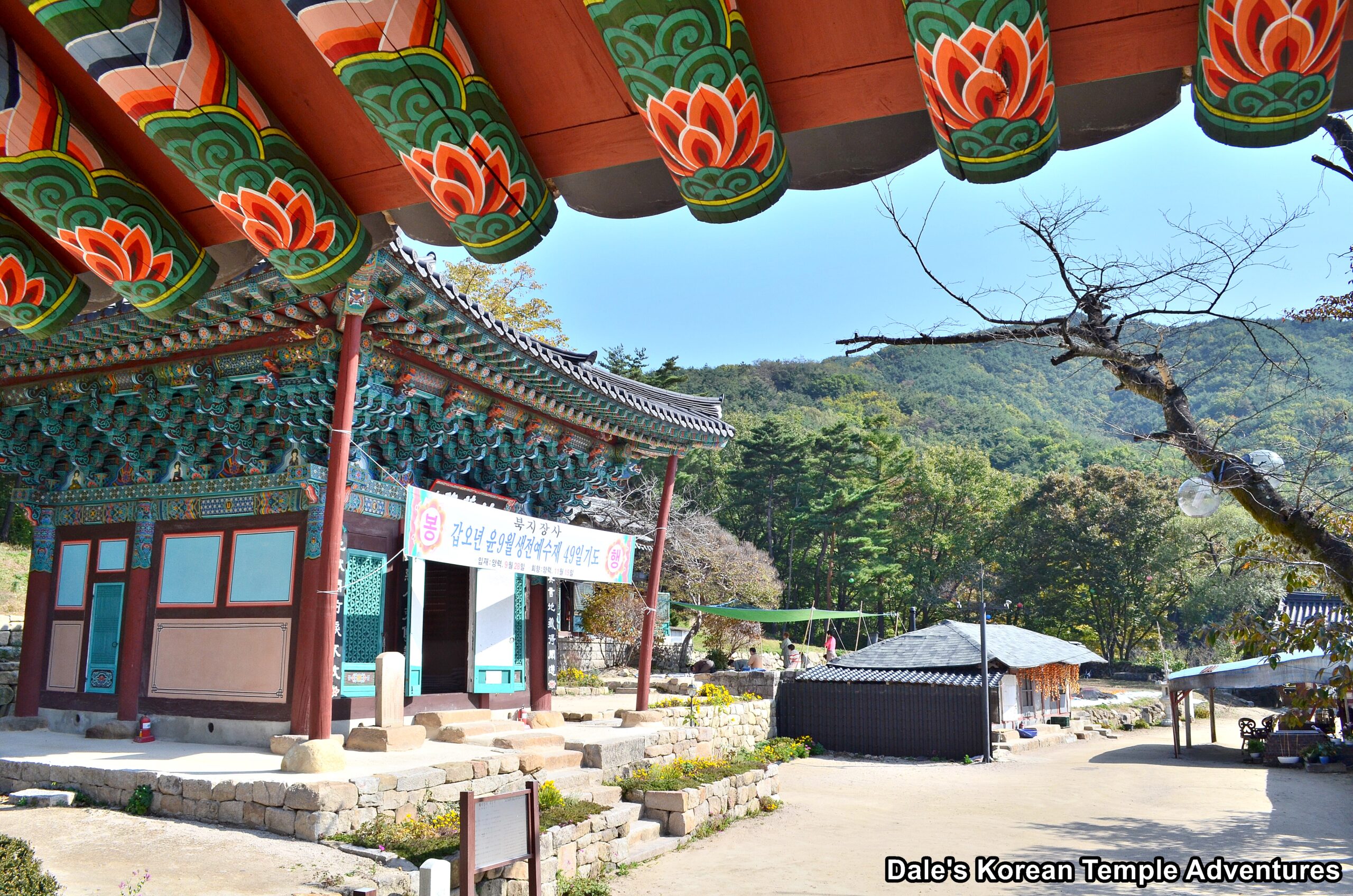
History of Dancheong
The oldest surviving example of dancheong in Korea dates back to murals found in the tombs of the Goguryeo Kingdom (37 B.C. – 668 A.D.). The dancheong design inside this tomb portrays the life of the tomb’s occupant. It also conveys wishes for their continued success in the afterlife. Dancheong was also employed in two other historic kingdoms in Korea: the Baekje Kingdom (18 B.C. – 660 A.D.) and the Silla Kingdom (57 B.C. – 935 A.D.). It was in the Goryeo Dynasty (918-1392) that the colours of green, red, black, and white became the standard choice for dancheong. Also at this time, simple dancheong motifs were painted.
During the Joseon Dynasty (1392-1910), a uniquely Korean form of dancheong was established. Because of two foreign invasions of the Korean peninsula by the Japanese during the Imjin War (1592-1598), as well as the Qing Invasion of Joseon (1636-1637), most of the historic structures on the Korean peninsula were destroyed with some noted exceptions like the Muryang-jeon Hall at Buseoksa Temple and the Daeung-jeon Hall at Sudeoksa Temple. That’s why most of the historic dancheong colour motifs that exist to this date are mostly from the latter half of the Joseon Dynasty. The dancheong colours from the late Joseon Dynasty are highlighted by bright yellow and intermediate colours like red-orange, blue-green, and yellow-green. This helped to add vibrancy to the dancheong colour schemes.
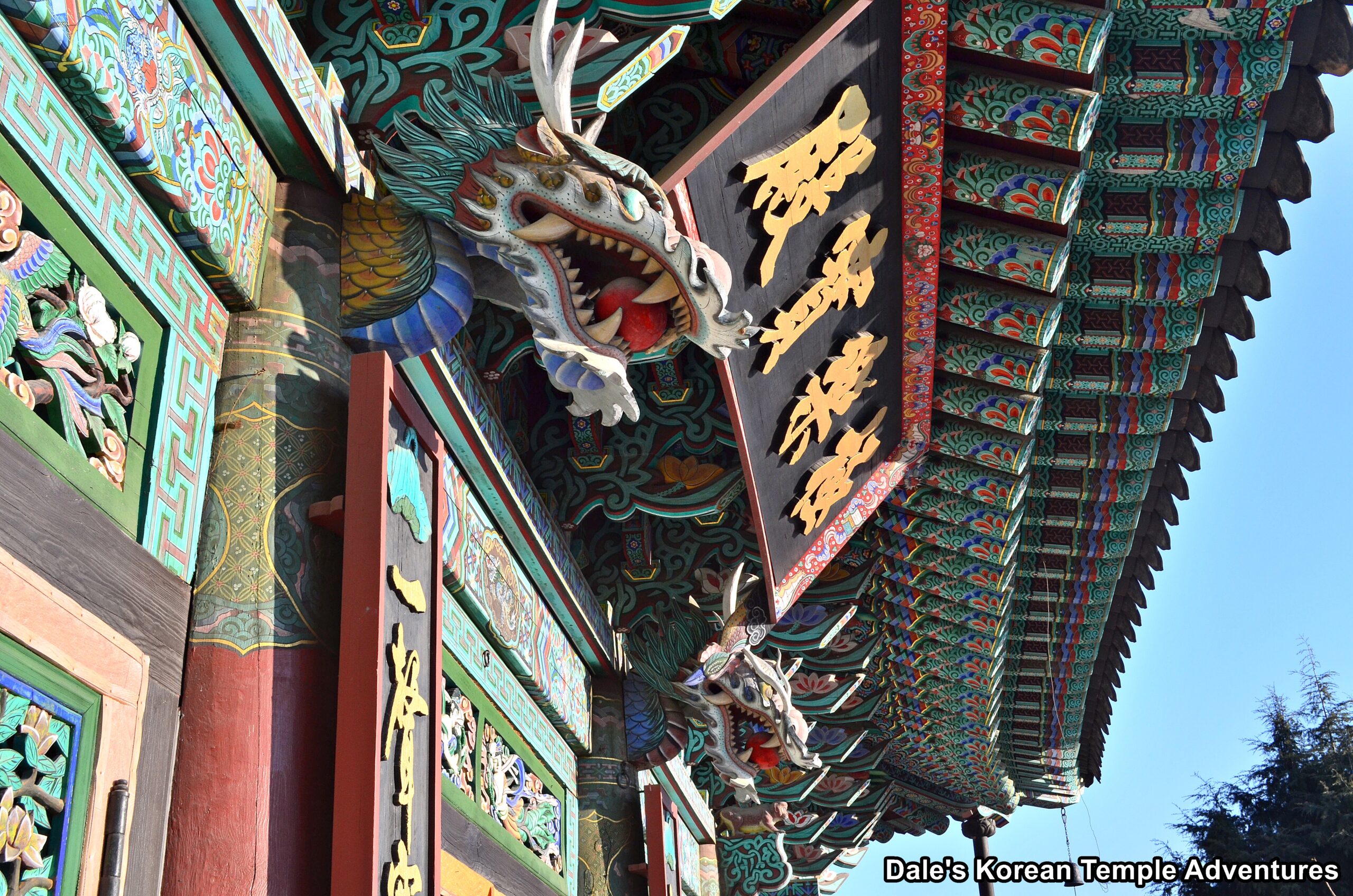
What is Dancheong?
Dancheong is the act of adorning interior and exterior wooden surfaces such as palaces, Confucian shrines, and Korean Buddhist temples and hermitages with a variety of colours and motifs. And there are several reasons as to why dancheong is applied to Korean Buddhist temples. The simplest reasons is that it’s meant to protect the wooden surfaces from weathering and insects. And another practical reason is to hide scratches and blemishes that might happen to the wooden surfaces of the shrine halls over time. It’s also meant to show dignity and beauty. Dancheong literally means “red and blue/green” in English. Originally, the word was in reference to the specific minerals used to help create the varying pigments in the paints that adorn Korean temples and hermitages. And while dancheong is used to help adorn Korean palaces, city gates, and Confucian shrines, the most elaborate styles of dancheong adorn Buddhist temples and hermitages. The reason for this difference is that this highly ornate style that adorns Buddhist temples and hermitages is reserved to honour the most sacred realm beyond the non-religious world.
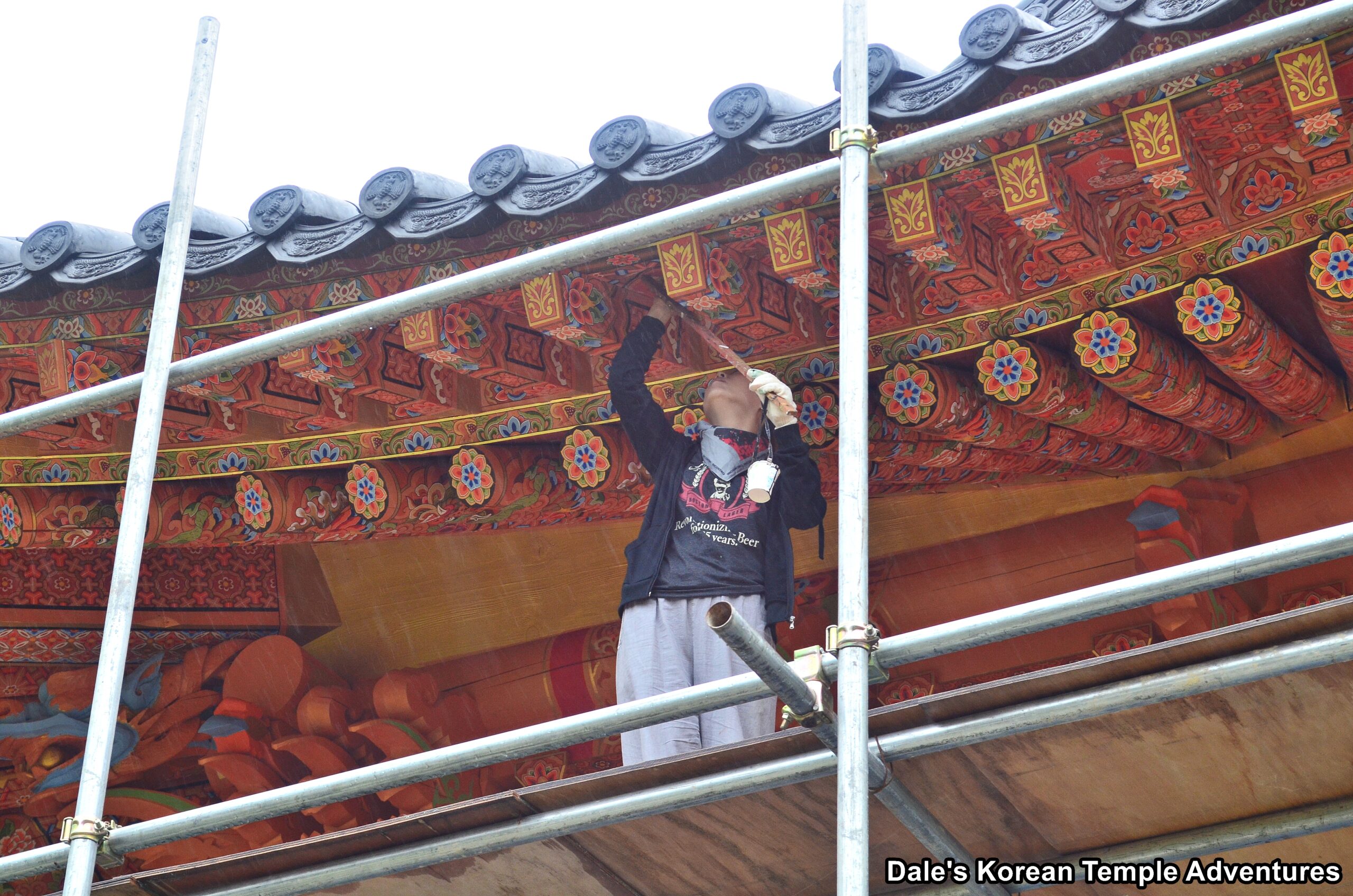
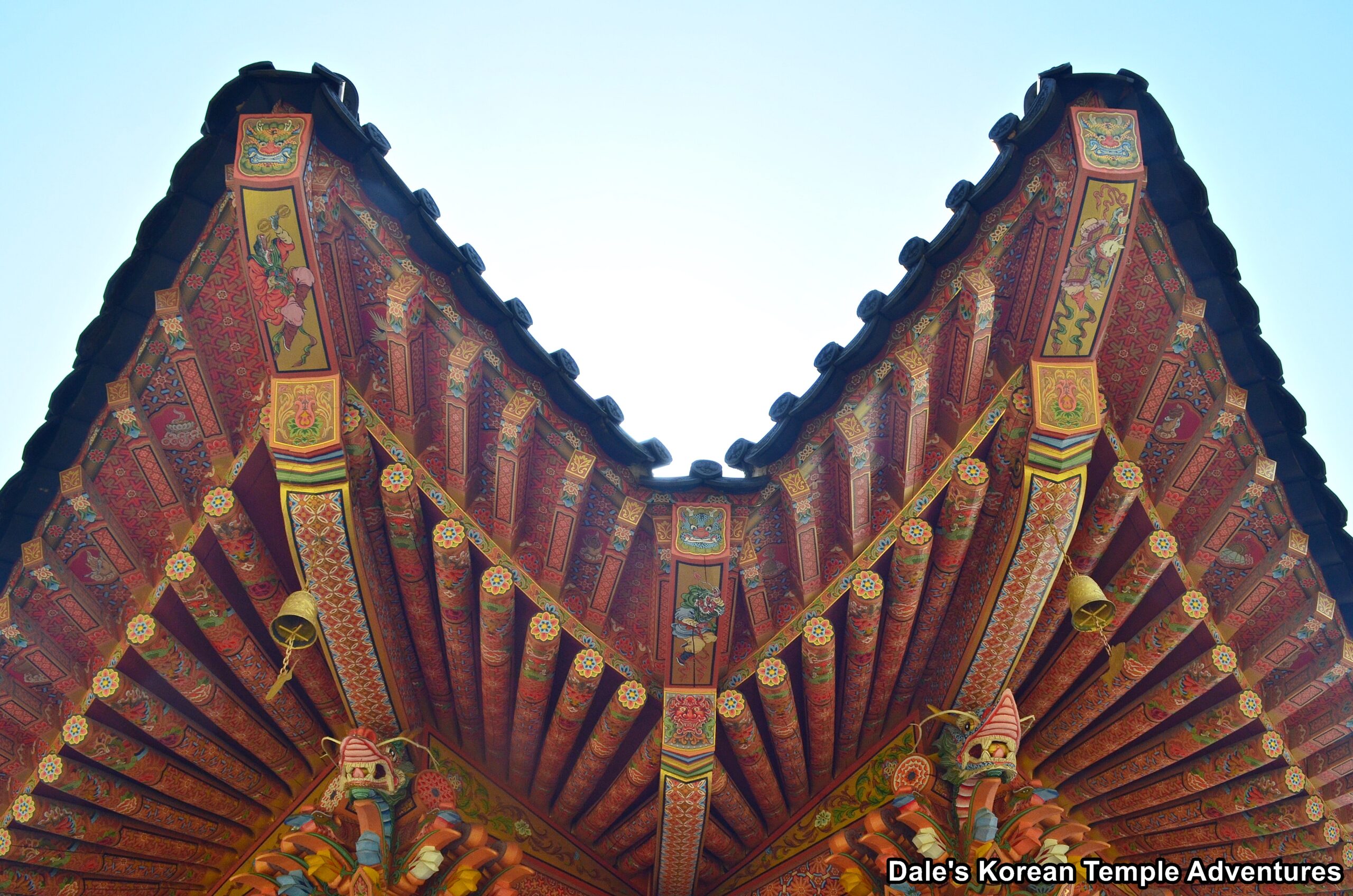
In total, there are five basic colours that are used in the design of dancheong. These five colours are related to each of the Five Elements Theory (a bit more on that later). Together, these colours symbolize the desire for stability, peace, and a rewarding afterlife. The five basic colours used in dancheong are blue, red, yellow, white, and black. Here’s what each is meant to represent:
1. Blue: wood, east, spring
2. Red: fire, south, summer
3. Yellow: earth, centre, time between seasons
4. White: metal, west, fall
5. Black: water, north, winter
In total, there are four main types of dancheong that adorn Korean Buddhist temples. They are:
1. Gachil-dancheong
2. Geutgi-dancheong
3. Moru-dancheong
4. Geum-dancheong
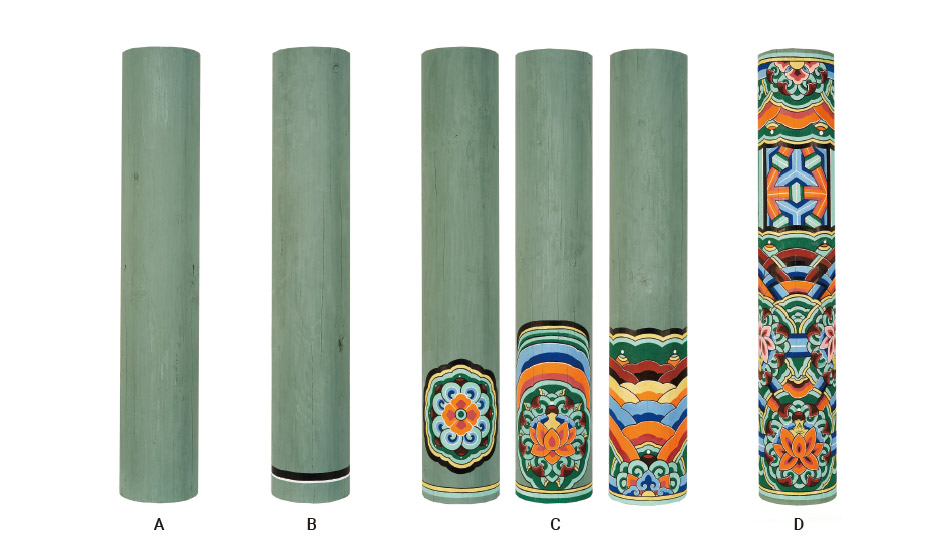
The first of these four types of dancheong is Gachil-dancheong. This is the simplest form of the dancheong style. This style employs the four basic colours of grass green, reddish brown, white, and yellow. These four colours are then applied to the bare wood of the temple structure. They are then either left plain, or they serve as the base for a more elaborate dancheong style.
The second dancheong style is Geutgi-dancheong. This style of dancheong involves painting straight lines across the border of a painted surface. Geutgi, in English, means “single stroke.” Most often in this dancheong style, a black border will be first drawn in ink. Only after the black line is painted is a white line added next to the black line. Occasionally, this style of line can be done in a number of colours other than black and white; but traditionally, the Geutgi-dancheong style is black and white.
The third style of dancheong is Moru-dancheong. This style of painting is first painted on rafters, various support beams, and shrine hall pillars. Moru means “end patterns” in English.
The fourth dancheong style, and the most elaborate, is Geum-dancheong. In English, Geum-dancheong means “elegant dancheong.” The Geum-dancheong is an embellishment of the Moru-dancheong style. The entire surface of the wooden face is covered in colourful and complex patterns and motifs. This style of painting consists of straight and curved lines that are woven through geometric shapes like circles and triangles to create a continuous repetitive pattern. This repetitive interconnected pattern is meant to symbolize the idea of the infinite.
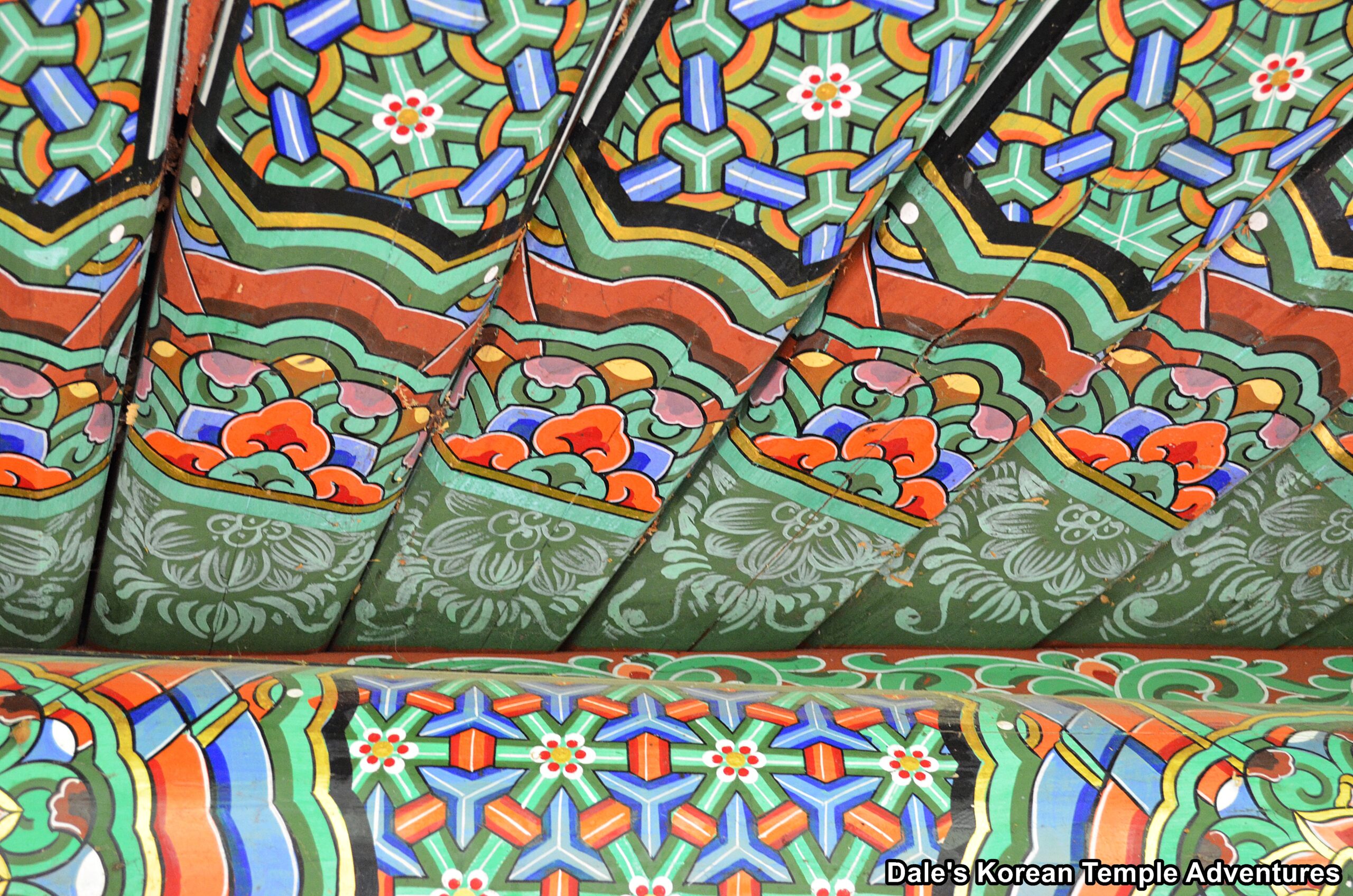
Specific patterns that can be included in Geum-dancheong are four unique patterns:
1. The Radiant Wave is meant to symbolize the illumination that is spread by the power of the Buddha’s teachings.
2. The Circle is meant to symbolize Samsara, which is the continuous cycle of birth, death, and rebirth. The Circle is also meant to symbolize how humans receive wisdom from the Buddha, if they believe strongly enough in the Buddha.
3. The Semi-Circle, on the other hand, is meant to resemble the nose-ring for cattle. This hearkens back to the metaphor taken from the highly symbolic collection of the ten Shimu-do (Ox-Herding Murals) that are commonly found at Seon Buddhist temples. Specifically, the semi-circle is meant to symbolize the Shimu-do which are murals that refer to the process of discovering Truth.
4. The fourth, and final Geum-dancheong pattern, are Triangles. Triangles are also called the Iron Armour pattern. This pattern is meant to encourage Buddhists to have firm resolve on their way towards the Truth.
Byeoljihwa (Separate Paintings)
In addition to these Geum-dancheong patterns, there is a subset of decorative murals called Byeoljihwa (separate paintings) that fall under this style of the Geum-dancheong style. This specific type of dancheong, Byeoljihwa, is only found at Korean Buddhist temple shrine halls. The subjects for Byeoljihwa are diverse. They can include Buddhas, Bodhisattvas, animals, birds, fish, flowers, spirits, guardians, symbols, and historic and legendary figures.
A: Byeoljihwa Flowers:
Lotus: There are multiple meanings for the lotus. One is that lotus grow in muddy water; but as it grows, the lotus rises from the muddy water as something beautiful and unsullied. This idea acts as a symbol of the Buddha’s teachings. The lotus represents the idea of purity, nobility, and the sublime. (Picture from Gakwonsa Temple in Cheonan, Chungcheongnam-do).
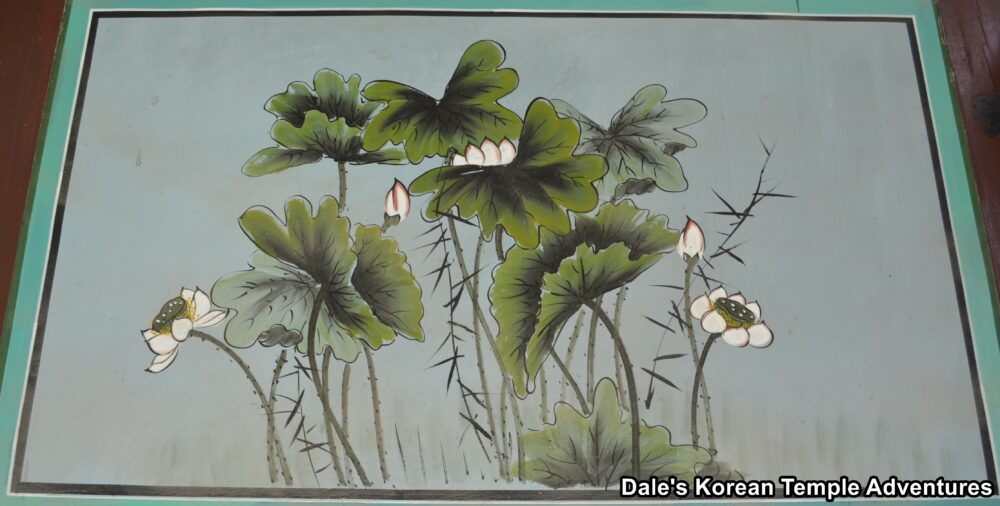
Peony: The peony is a symbol for prosperity, beauty, good fortune, and wealth. (Picture from Anyangam Hermitage in Yangsan, Gyeongsangnam-do).

Peony and Rose: When painted together, these flowers are meant to symbolize wealth, honour, and a long spring.
Peony and a Stone or Peach: This combination is meant to symbolize a wish for a long life, wealth, honour.
Peony and Daffodil: This pair is meant to symbolize the Taoist Immortals, wealth, and nobility.
B: Byeoljihwa Birds and Insects
The White Crane: Cranes exist in nature, but they have a mysterious quality to them. They are known to live in secluded areas, which parallels the idea of a Buddhist recluse in search of the Truth. (Picture from Gapsa Temple in Gongju, Chungcheongnam-do).
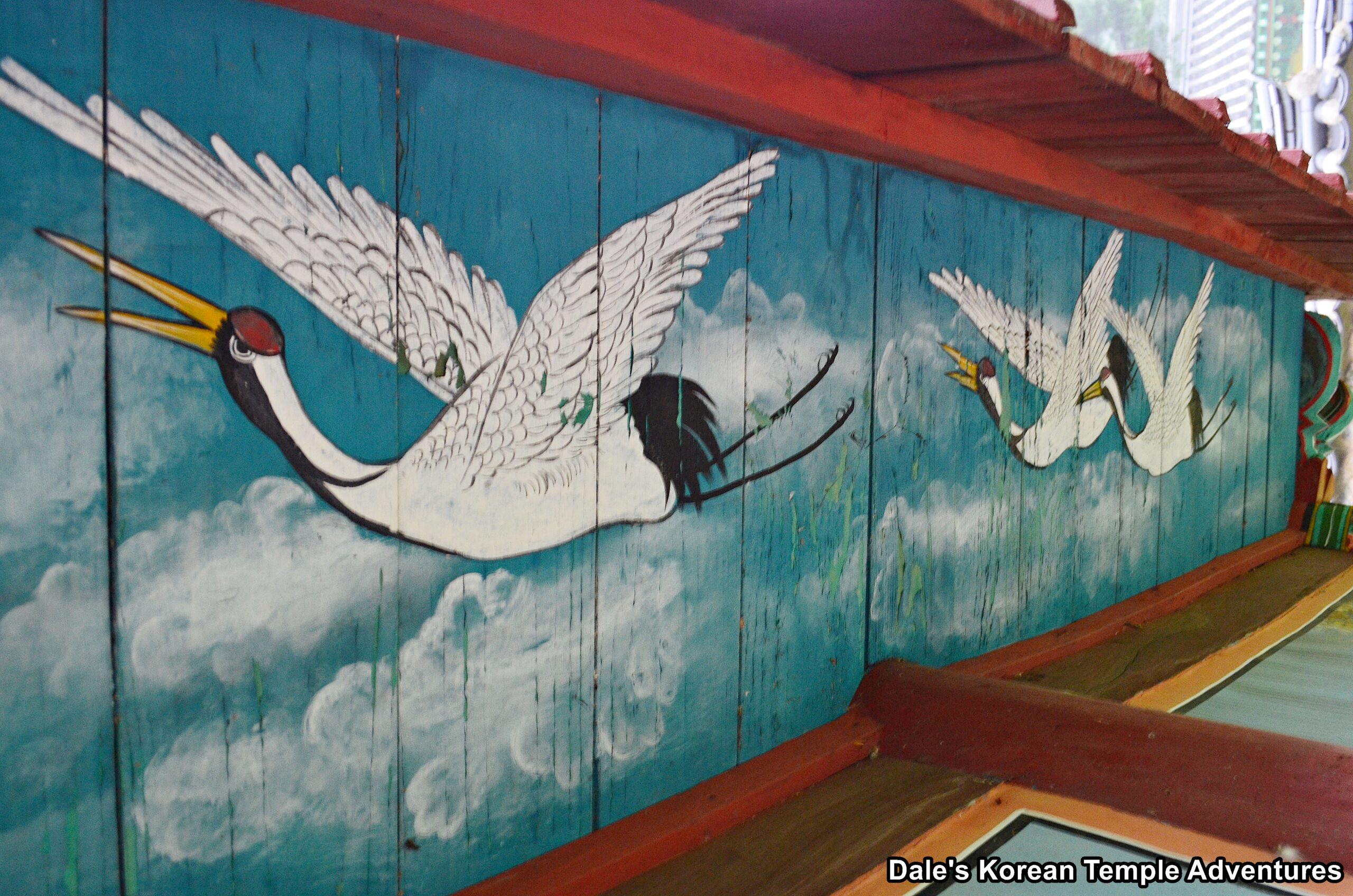
The Phoenix: The phoenix is associated with an untainted nature. It eats bamboo, but it never eats dead things even when hungry. (Picture from Banyaam Hermitage in Yangsan, Gyeongsangnam-do).
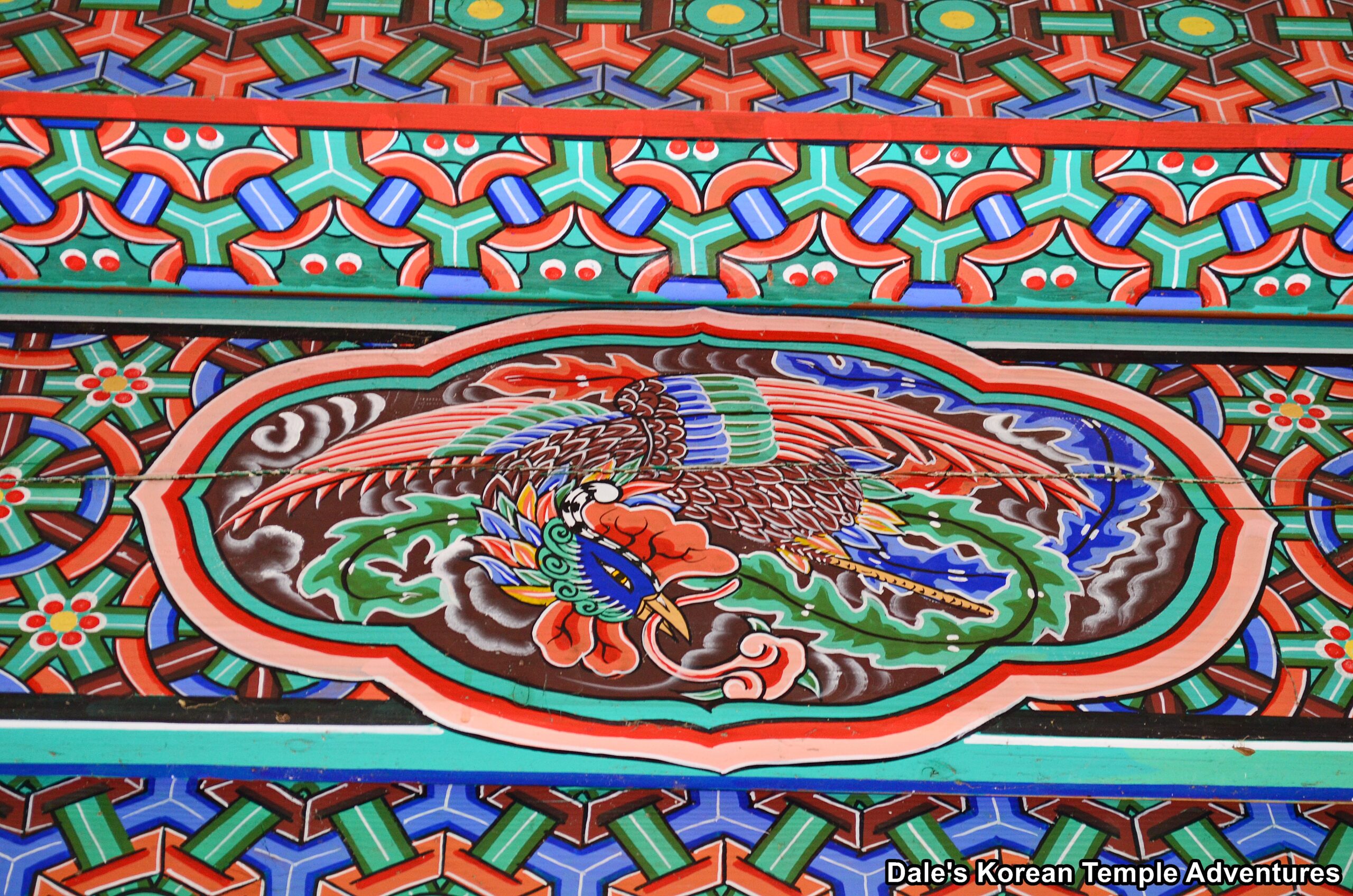
Waterfowl (ducks, swans, geese): These birds live a multi-mode existence. They can live in water, on land, or in the air. The Buddhist term for this is “unobstructed” or “liberated,” which is symbolic of the freedom gained from the cycle of Samsara (birth, death, and rebirth). Therefore, they are a symbol of ultimate freedom. (Picture from Samseongam Hermitage in Changnyeong, Gyeongsangnam-do).
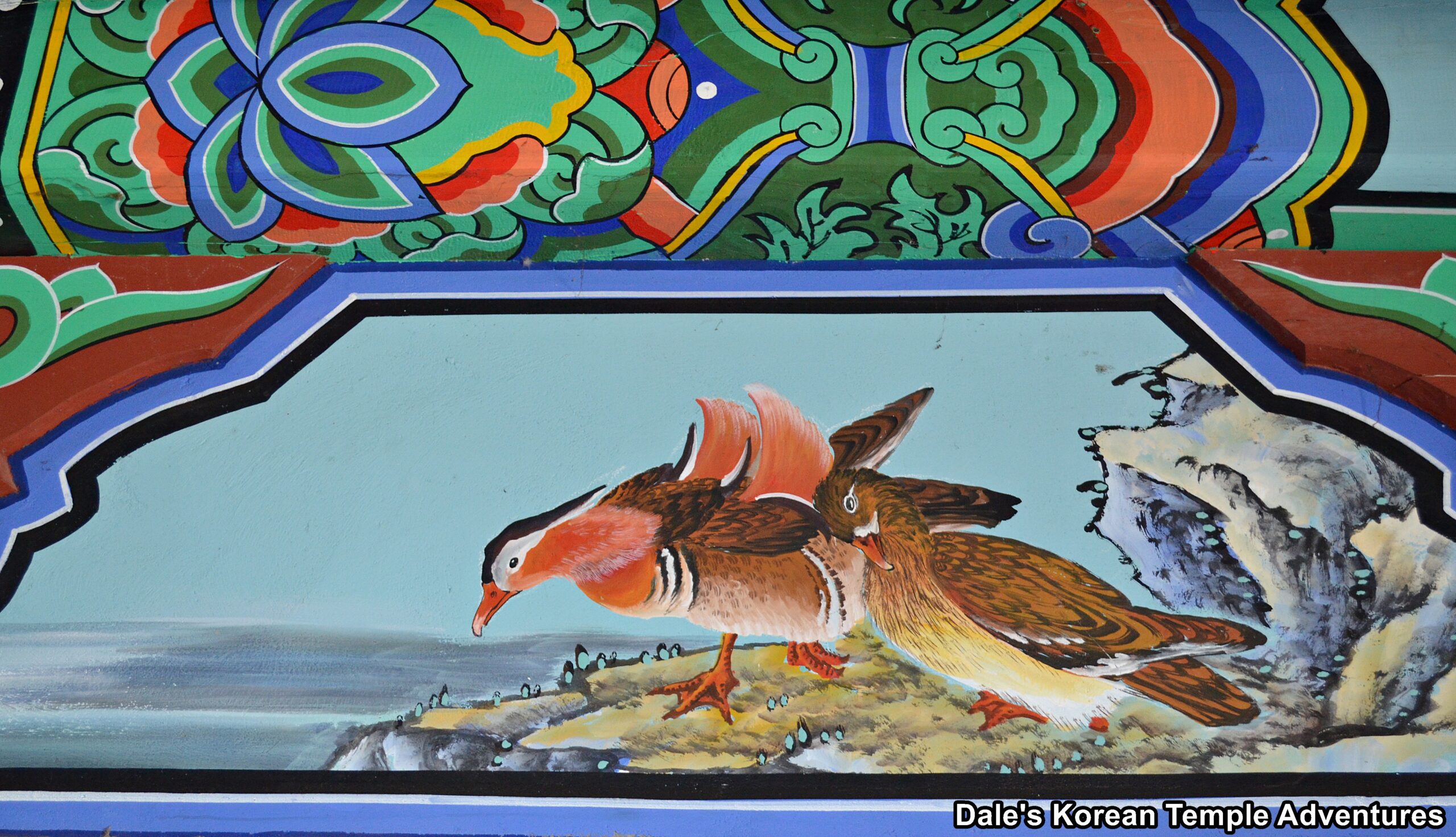
Magpie: A magpie is thought to bring good luck. In Hanja, the character for “joyful” is included in this character. Magpie and Tiger paintings were especially popular during the Joseon Dynasty, as they juxtaposed authority and the aristocratic yangban in the form of the tiger with the dignified magpie representing the common man. These paintings are known as Ggachi-Horangi Minhwa. (Picture from inside the Myeongbu-jeon Hall at Tongdosa Temple in Yangsan, Gyeongsangnam-do).

Butterflies: The butterfly is depicted as flying gracefully and with brilliant colours, so the butterfly is meant to symbolize the idea of grace. (Picture from Gwanryongsa Temple in Changnyeong, Gyeongsangnam-do).
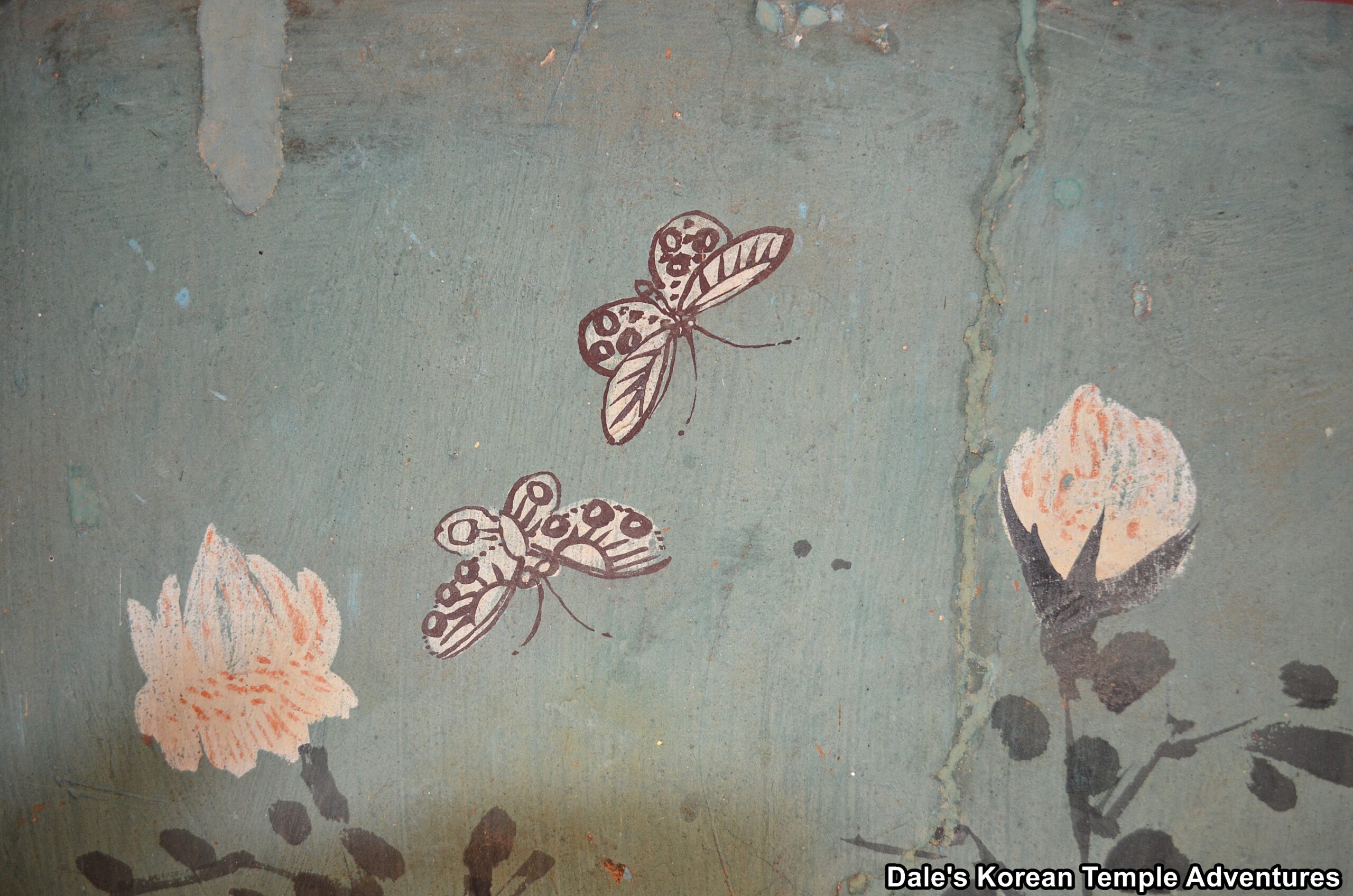
C: Byeoljihwa Animals and Fish
White Elephant: White elephants are a sign of good luck, as the Korean pronunciation of the character for elephant (sang) also means “lucky omen.” (Picture from Pyochungsa Temple in Miryang, Gyeongsangnam-do).
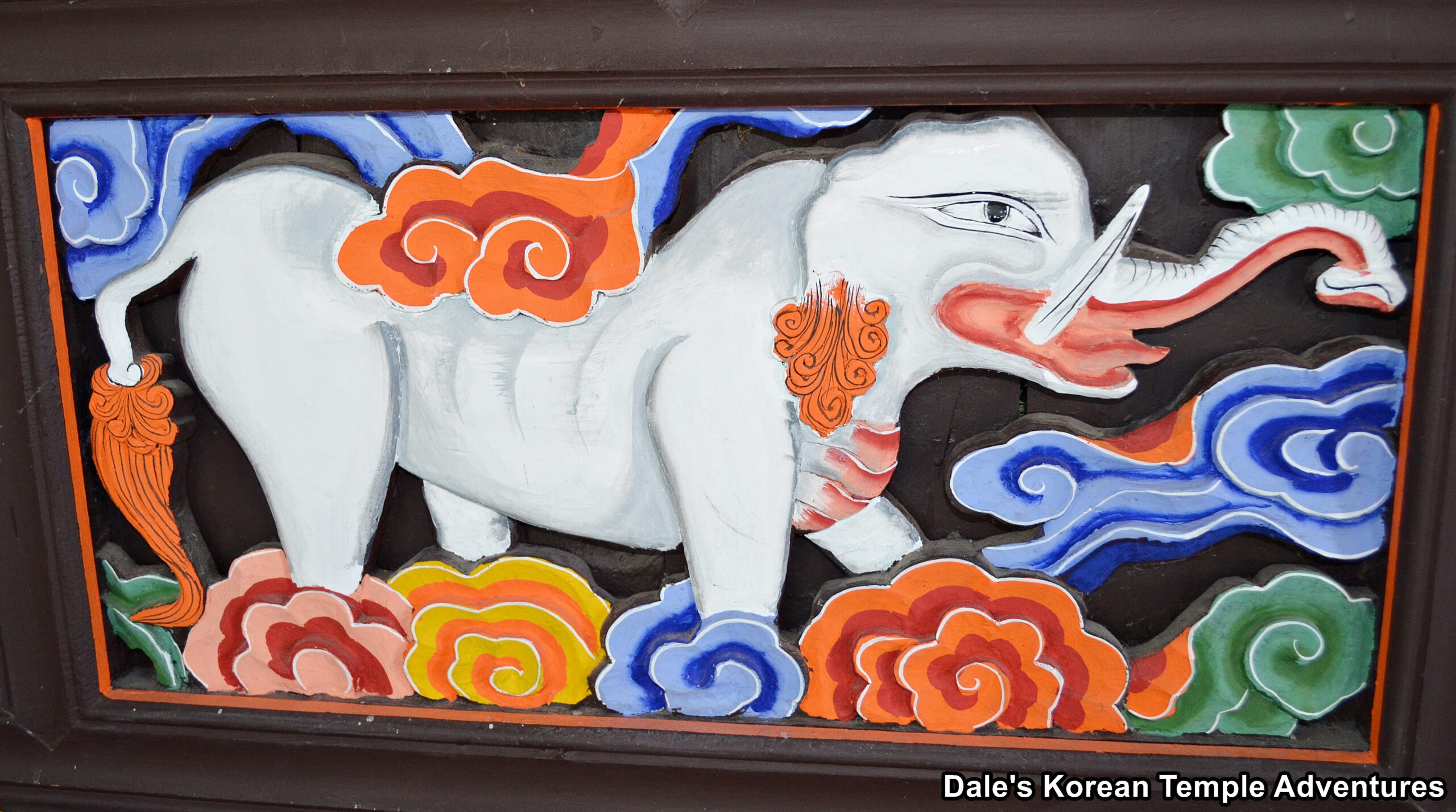
Tiger: A tiger’s ferocity was believed to be a force for warding off evil spirits. They were also used during New Years pictures and objects. So the tiger is used as a symbol for repelling evil spirits and inviting good fortune. (Picture from the Sanshin-gak Hall at Gakwonsa Temple in Cheonan, Chungcheongnam-do).
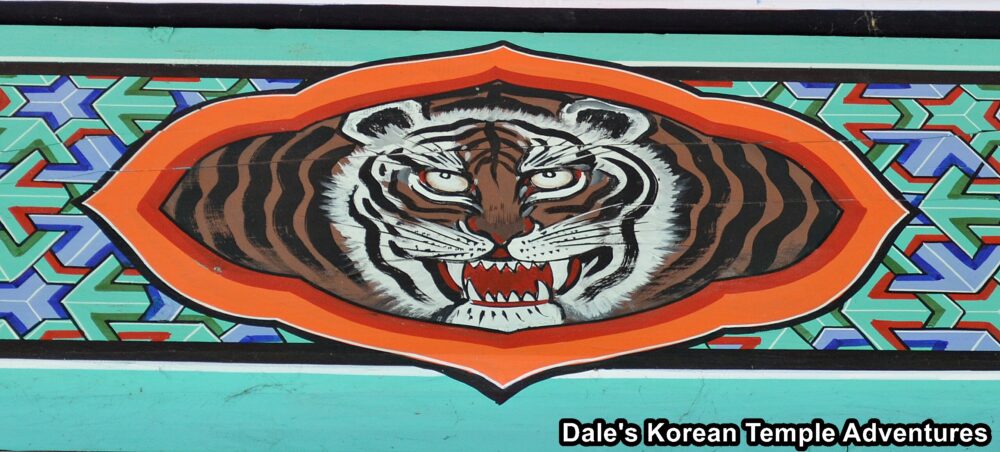
Fish: Typically, animals are not allowed to grow on temple grounds with the exception of carp/Koi. These fish grow in lotus ponds. As a result, fish are associated with freedom. (Picture from Mireuksa Temple in Geumjeong-gu, Busan).
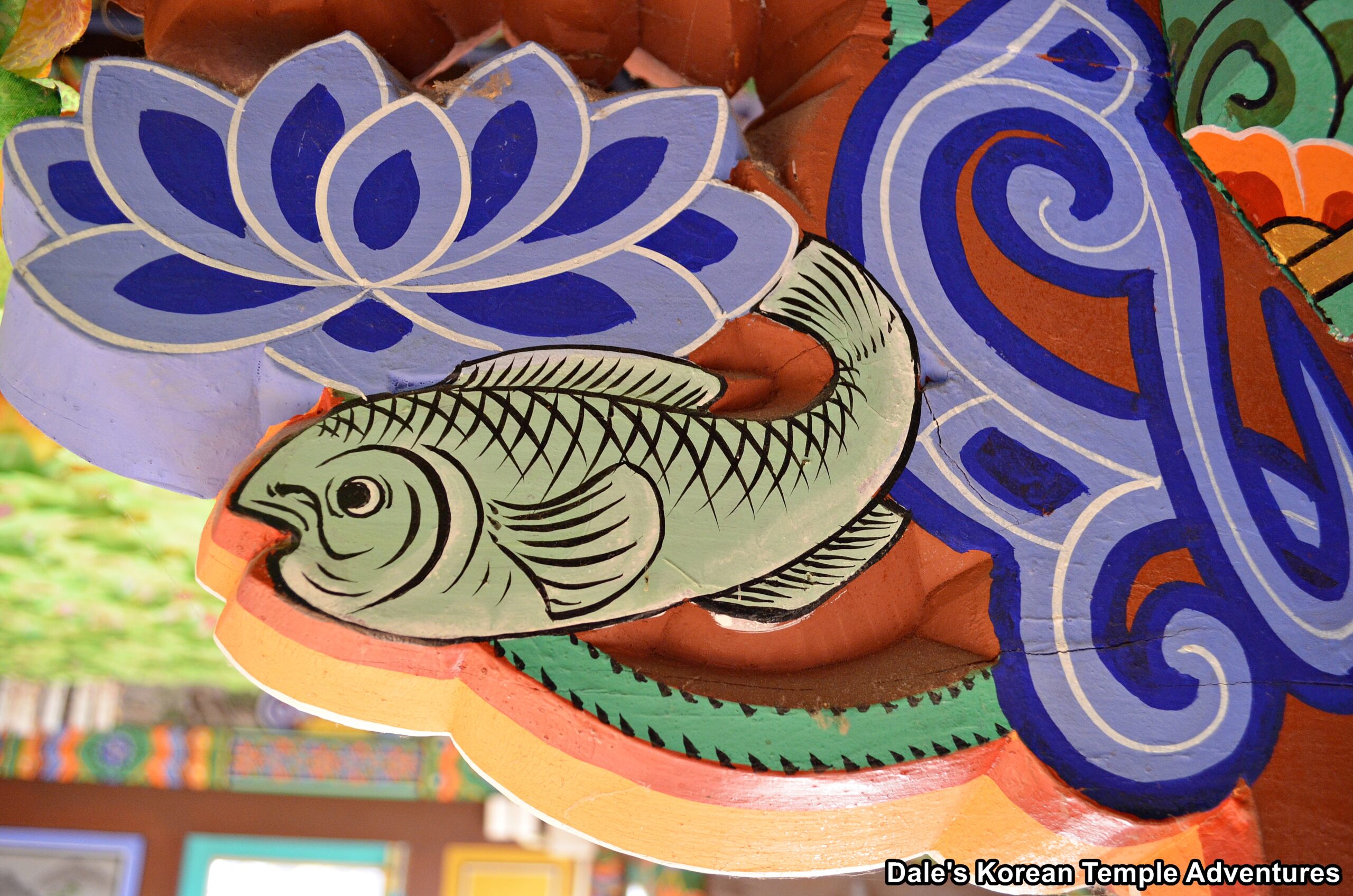
Turtles: Much like the Dragon Ship of Wisdom, the turtle is believed to transport the dead across Samsara to the Pure Land. (Picture from Bohyeonsa Temple in Yangsan, Gyeongsangnam-do).
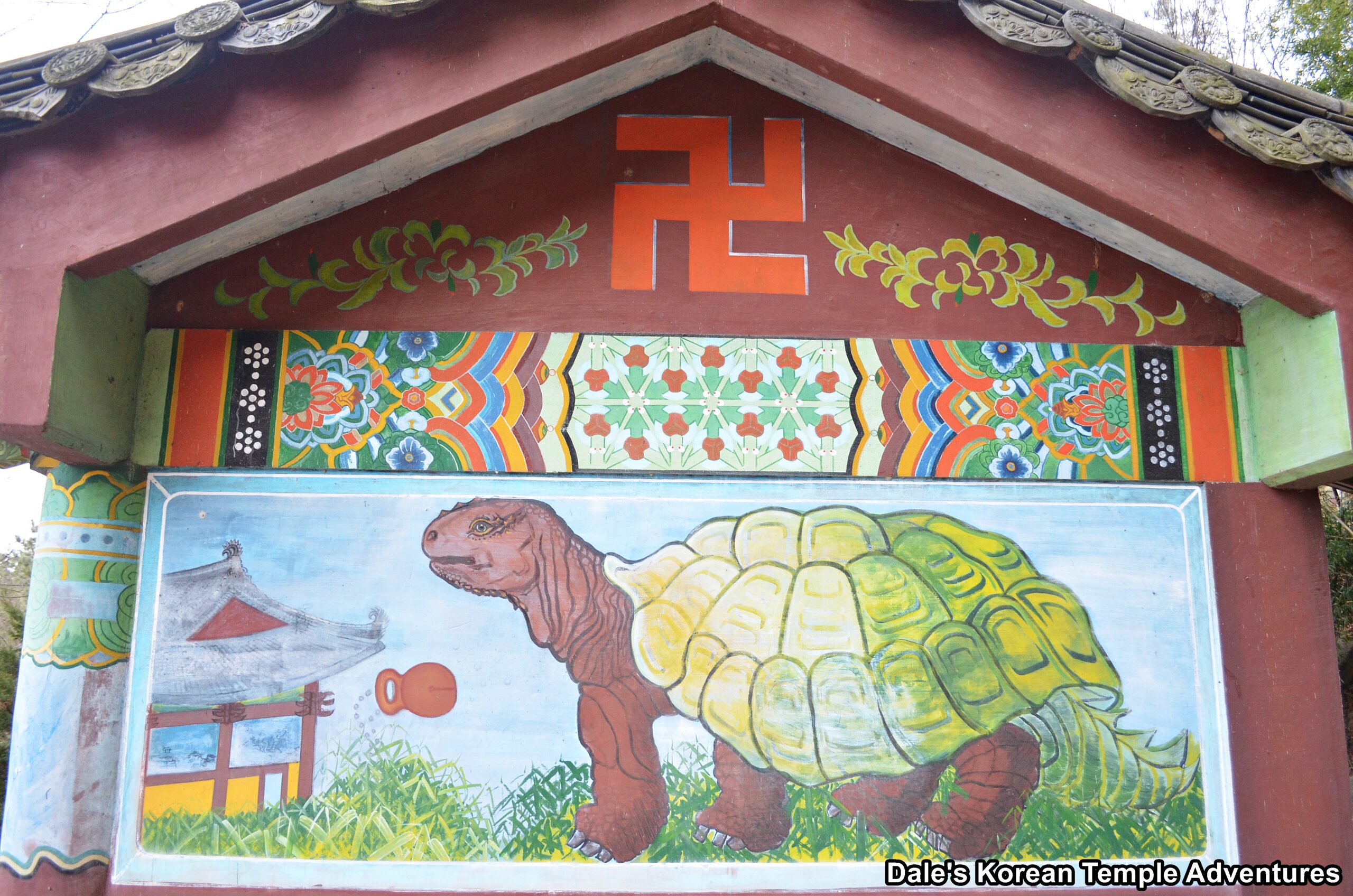
Dragons: A dragon is a guardian that wards off evil spirits. Originally, a dragon was a Naga. When the Naga traveled to China, it became a dragon; and thus, the symbolic meaning of the dragon traveled onward to the Korean peninsula. (Picture from Cheongryeonam Hermitage in Geumjeong-gu, Busan).
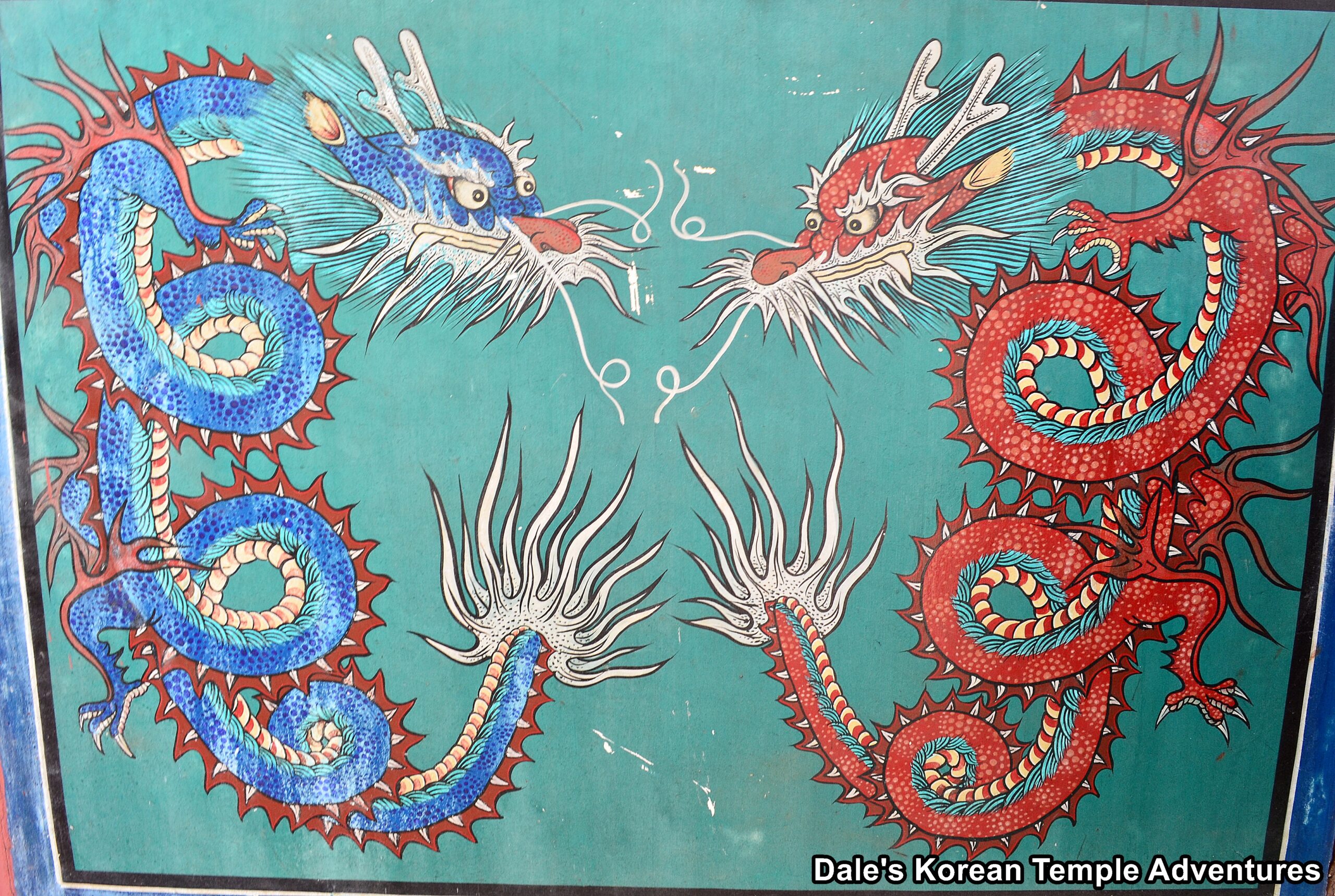
6. Hare: The hare is depicted as a clever creature. Its smart character allowed it to frustrate the tiger in Korean folktales. Also, it’s considered to be free of evil influences, and its long ears are a sign of long life.
D: Byeoljihwa Guardians and Spirits
Bicheon (Flying Heavenly Deities): Bicheon are heavenly figures that praise the Buddha while flying around in the sky in the rarefied air of the Buddhist heavens. They can either be dancing, playing a musical instrument, or sprinkling flowers. They wear fluttering robes and are typically female. (Picture from Heungbuam Hermitage in Gimhae, Gyeongsangnam-do).
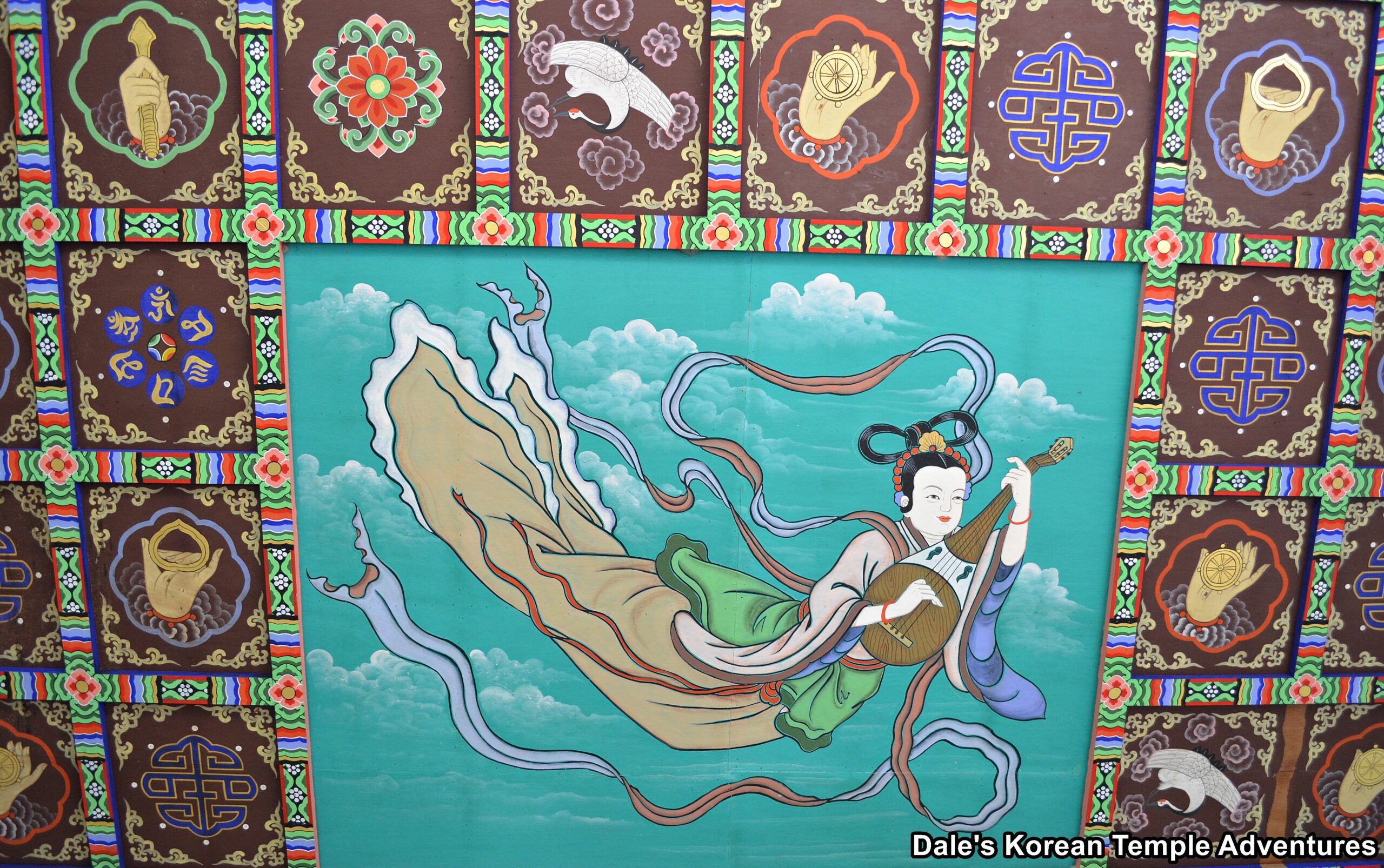
Kalaviṅka (or “Gareungbinga – 가릉빈가” in Korean): They are a fantastical creature in Buddhism that has a human head and a bird’s body with a long flowing tail. They are said to dwell in the Western Pure Land and teach the Dharma with its beautiful voice. (Picture from Gwaneumsa Temple in Yangsan, Gyeongsangnam-do).
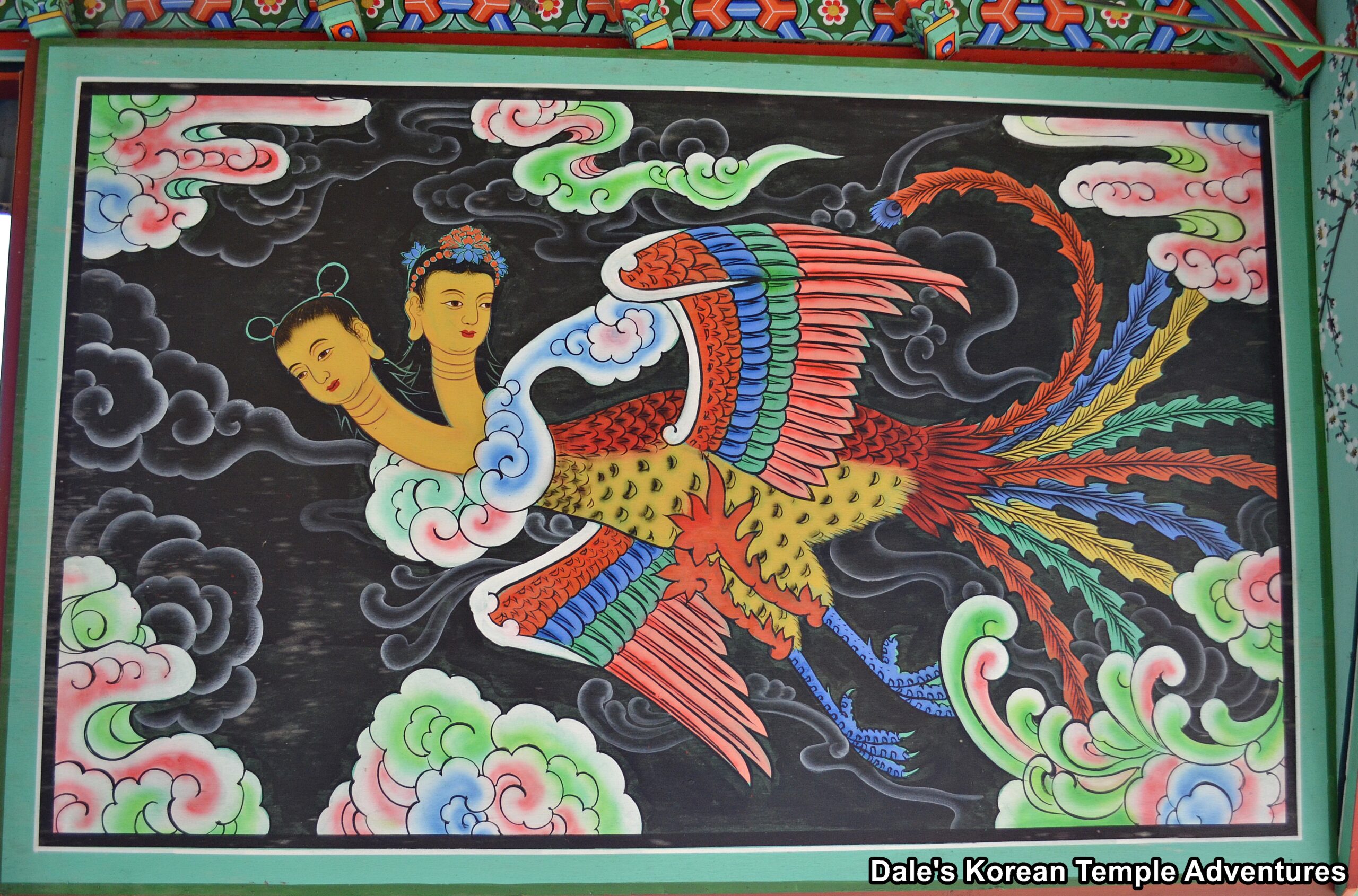
Gwimyeon (Monster Mask): They can have facial hair, whiskers, horns, be crossed eyed, and have large teeth. They can also hold a wisdom pearl, fish, or flowers in their mouth or simply nothing at all. Above all else, they are guardians. If they are alone, their eyes usually only point straight ahead. If they are in a group, they stare in different directions to ward off as many evil spirits as possible. (Picture from Seokbulsa Temple in Buk-gu, Busan).
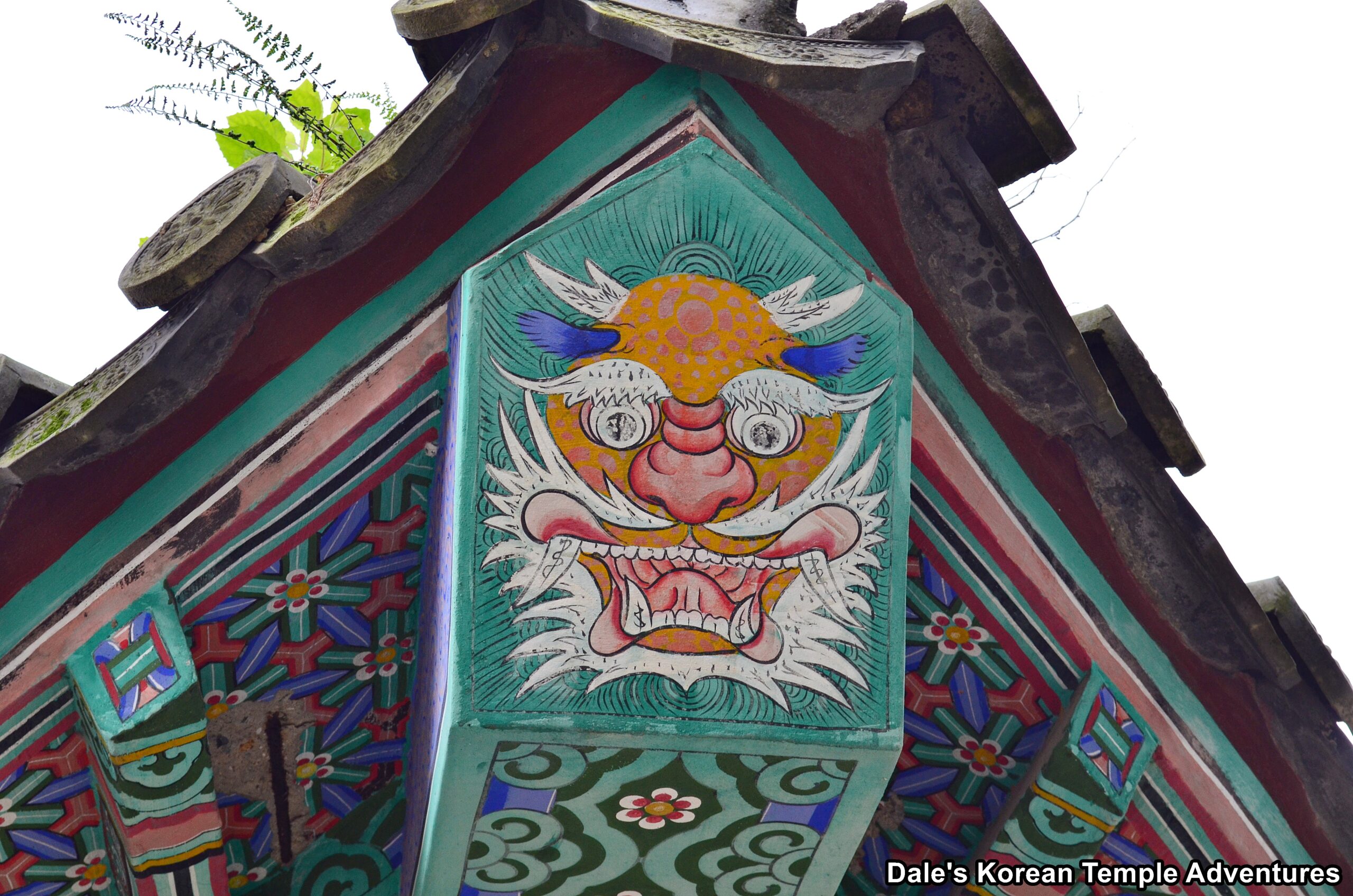
E: Byeoljihwa Other
Eight Buddhist Treasures: The Eight Buddhist Treasures are the Dharma wheel, conch shell, precious umbrella, white canopy, lotus blossom, precious vase, goldfish, and an endless knot. These items are purportedly at the bottom of the Buddha’s foot. They are all objects of veneration. The Taoist and Buddhist treasures are interchangeably used, pointing towards a simple lack of understanding on the part of the artists. (Picture from Songnimsa Temple in Chilgok, Gyeongsangbuk-do).

Eight Taoist Treasures: The Eight Taoist Treasures are the pearl, lozenge, hand bell, water buffalo horn, brass coin, two books tied, wormwood leaf, and a mirror. Here’s what each symbolizes: The Pearl (beauty); Lozenge (victory over nature); Hand Bell (celebration, happiness); Water buffalo horn (good luck); Brass coin (controlling even spirits); Books (auspiciousness); Leaf (good luck, bountiful farming, and drive away disease).
Manja (Swastika): The Manja is a reference to good luck or auspiciousness. (Picture from Jangansa Temple in Gijang-gun, Busan).
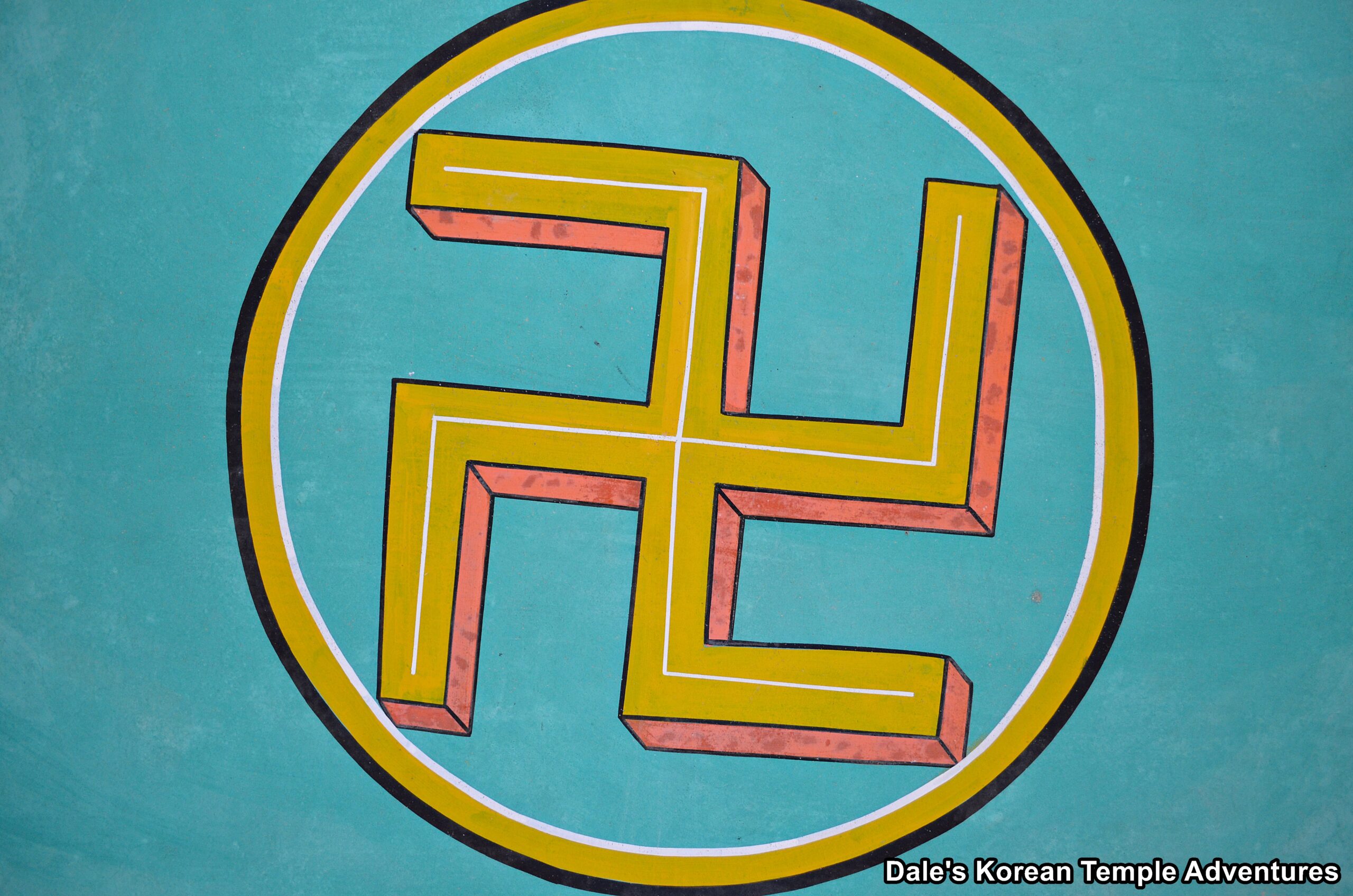
Yin-Yang (Supreme Ultimate): There are two types. There’s the triple comma version, and there’s the dual comma version which appears on the Korean flag. The dual comma version symbolizes the yin and yang force. The two forces are separated in a circle but are dependent upon each other, so they are fused together. They are coloured red and blue. The triple comma version, on the other hand, represents the three powers (heaven, earth, humans) and are coloured red, blue, and yellow. The biggest reason that this symbol appears at Korean temples is that it embraces the belief of the interconnectedness of existence. (Picture from the Bulimun Gate at Tongdosa Temple in Yangsan, Gyeongsangnam-do).

The Five Elements Theory: The Five Elements Theory is a Chinese philosophy that discusses the relationships between things. The five elements are wood, fire, earth, metal, and water. It’s believed that these five fundamental elements are the basis for all interactions in the universe.
Musicians: They are symbols of praise, offerings, and reverence.
Stylized Chinese Characters: They are symbols for long life and good fortune.
Conclusion
It’s amazing that something that can appear so simple can be quite sublime. Dancheong can also be beautiful in its wonderful complexity of colour and style. It’s packed with highly symbolic meaning from the colour, to the design, and onto more elaborate motifs and murals. So the next time you’re at a Korean Buddhist temple, have a closer look at the world of colours around you. You might just be surprised with what you see and what it all means.

2 Comments
Lois
I’m puzzled.
The tiger us a force for good that can ward off evil spirits. The hare us a clever creature that can out smart or frustrate the tiger but is also a force for good. Why would the hare, a force for good be frustrating the tiger who is also a force for good?
Fun to read and see these photos and descriptions.
admin
Hello Lois,
I should have been more specific in the article because content and context matter. If a tiger is alone or with Sanshin it’s thought of as warding off evil spirits. However, if the tiger is with a hare or magpie it’s meant to represent aristocratcy and the yangban like in the Magpie and tiger paintings that were famous during the Joseon Dynasty. Hope that makes more sense.